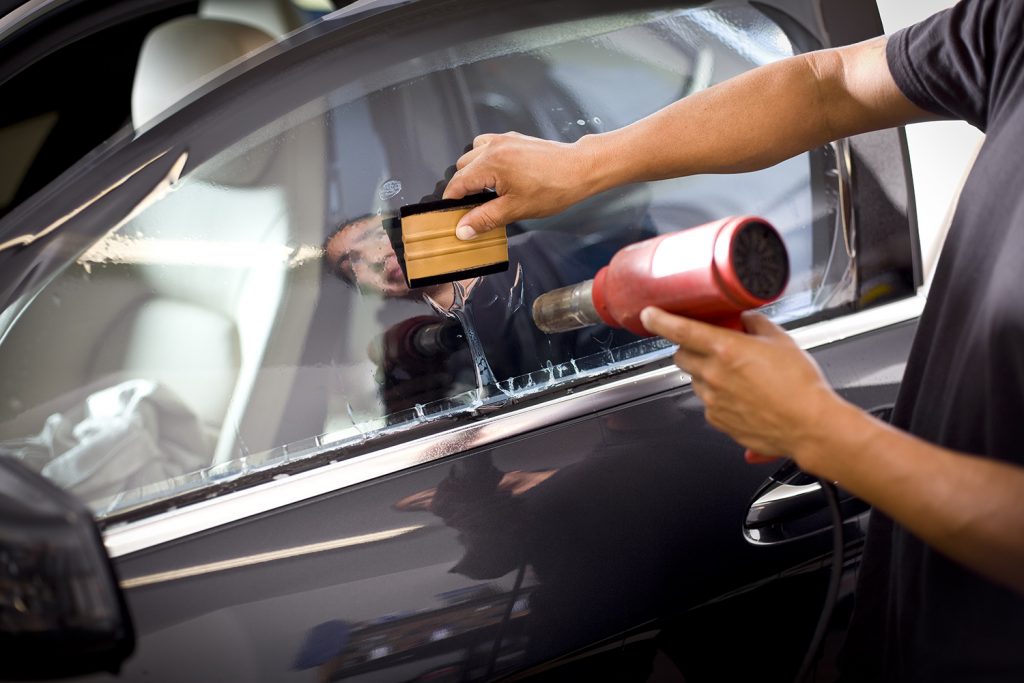Why Window Tinting is Necessary for Shielding Your Car's Interior
Why Window Tinting is Necessary for Shielding Your Car's Interior
Blog Article
The Refine of Expert Home Window Tinting Explained
From choosing the right film kind to the thorough preparation of windows, each step plays a critical function in achieving a remarkable application. Adhering to these initial preparations, the careful cutting and application of the movie demand accuracy to stay clear of imperfections.
Selecting the Right Window Movie
Choosing the right window movie entails understanding different aspects that affect both aesthetic appeal and functionality. The preliminary factor to consider is the kind of film, which can range from colored, metalized, to ceramic movies. Dyed films primarily provide personal privacy and visual enhancement, while metalized movies reflect warm and UV rays, enhancing power performance. Ceramic films, although commonly a lot more costly, deal superior efficiency without jeopardizing exposure.
Following, think about the film's Visible Light Transmission (VLT) percentage, which establishes how much light gets in the room. A reduced VLT gives better privacy and heat rejection yet may decrease all-natural light substantially. Furthermore, the movie's solar heat gain coefficient (SHGC) is critical; a reduced SHGC indicates better thermal performance, aiding to keep indoor comfort.

Preparing the Windows
Once the suitable home window movie has actually been picked, the following step is thoroughly preparing the home windows for setup. This preparation is essential for attaining optimal bond and making sure a flawless look post-installation.
The initial job involves cleansing the home windows carefully (window tinting). A top quality glass cleanser is important, ideally one that is ammonia-free to avoid damaging any home window seals or tint materials. Making use of a lint-free cloth or paper towels, professionals must remove any kind of dirt, dirt, or oil, paying special focus to the edges and edges where debris frequently accumulates

Reducing the Movie
An accurate strategy to cutting the movie is vital for making sure a perfect fit on the ready windows. This step needs both skill and interest to detail, as mistakes can cause undesirable gaps or overlaps that concession the visual and useful qualities of the tint.
Before reducing, the expert should determine the home window dimensions properly, representing any kind of unique forms or shapes. It is advisable to make use of high-grade window movie, as this product has a tendency to be extra forgiving throughout look at this site the reducing procedure. The movie is typically laid level on a clean, smooth surface area, and a sharp utility knife is utilized to make certain tidy sides.
To accomplish optimal results, several experts make use of themes created from previous installments or utilize software to develop precise patterns. An usual method includes adding an extra margin to the theme, enabling adjustments during the application stage.
Additionally, cutting the film in a regulated environment reduces the danger of pollutants affecting the glue side. By sticking to these careful techniques, home window tinting experts can make sure that the film not just fits seamlessly yet also does successfully in time, improving both appearance and capability.
Applying the Color
After diligently cutting the movie to the right measurements, the following action entails applying the color to the window surface. This process begins with guaranteeing that the home window is tidy and without any dirt, debris, or deposits that can affect adhesion. A customized cleansing remedy is typically used, adhered to by extensive drying with a lint-free fabric.
When the surface area is prepared, the installer will very carefully place the tint film versus the glass. It is crucial to line up the film precisely to stay clear of misplacement, as any errors can result in a less than professional appearance. To promote this, the installer may use a light mist of application official source option on the glue side of the movie, enabling mild repositioning if necessary.
Using a squeegee, the installer will then begin to press the movie onto the glass, functioning from the center outwards to remove air bubbles and guarantee a firm bond. This strategy is important, as it assures a smooth and remarkable surface. Throughout the application, focus to information is important to stop creases or blemishes, ensuring that the tint not only boosts aesthetic appeals yet additionally offers the wanted functionality.
Last Assessment and Treatment
The last evaluation is a vital action in the home window tinting procedure, ensuring that the installment fulfills both aesthetic and functional requirements. During this phase, specialists meticulously examine the mounted color for any type of blemishes, such as bubbles, folds, or misalignments. A comprehensive examination likewise consists of inspecting the adherence of the movie to the glass, as well as its harmony and overall appearance.
After the examination, correct care and upkeep instructions are provided to the customer. It is important to inform them concerning the suggested timeline for cleaning up the tinted home windows, commonly encouraging a delay of at the very least 1 month after installment to allow the glue to treat fully. Customers must be educated on suitable cleansing items and techniques, stressing the avoidance of ammonia-based cleansers that can damage the color.
Furthermore, professionals need to advise customers on the importance of normal upkeep to extend the life of the tint. This includes routine look for indications of wear or damage and reacting promptly to any kind of problems. By guaranteeing a detailed last evaluation and offering clear care standards, window tinting professionals enhance consumer satisfaction and the long life of their work.
Conclusion
The professional home window tinting process incorporates numerous vital actions that guarantee high-quality results. Choosing the useful content ideal film kind, preparing the home windows thoroughly, properly reducing the movie, and applying it with accuracy are important for attaining a flawless coating.
Report this page